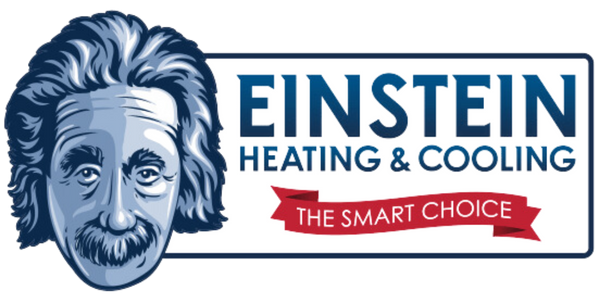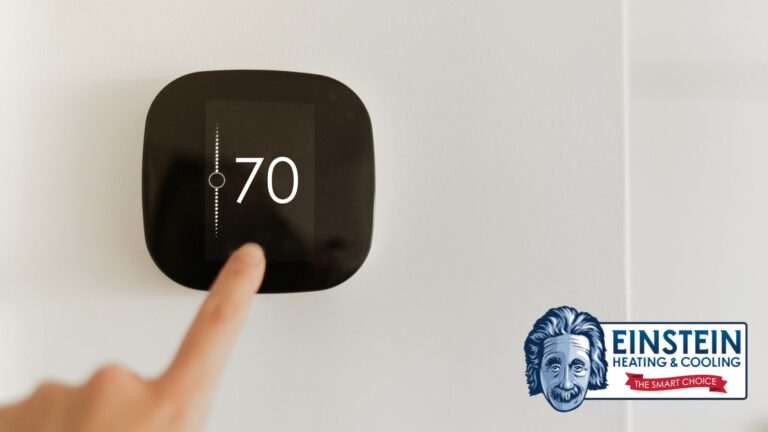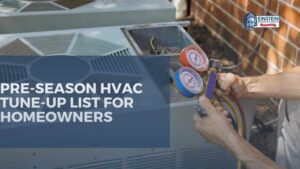As we strive towards a sustainable and energy-efficient future, the heating and cooling industry is undergoing significant transformations. The Maricopa County, Arizona area, like many other regions, is witnessing innovations that promise to revolutionize the way we heat and cool our buildings. In this blog, we will explore the advancements and trends that are shaping the future of heating and cooling systems in the Maricopa County, Arizona area.
Smart Thermostats and Energy Management Systems
Smart thermostats and energy management systems have revolutionized the way we control and manage heating and cooling in our homes and businesses. In the Maricopa County, Arizona area, these innovations offer immense benefits to users who are seeking energy efficiency and convenience.
One of the key advantages of smart thermostats is their ability to learn and adapt to user preferences. Through advanced algorithms, these devices analyze temperature patterns, occupancy, and user input to create personalized heating and cooling schedules. This means that users no longer have to manually adjust the thermostat throughout the day. Smart thermostats can automatically adjust temperatures based on occupancy, ensuring comfort when needed and energy savings when spaces are unoccupied.
Moreover, smart thermostats provide users with remote access and control. With the help of smartphone apps or web interfaces, homeowners and business owners in Maricopa County, Arizona can monitor and adjust their thermostat settings from anywhere. This feature is particularly useful for those who want to make temperature adjustments while away from home or optimize energy usage during peak hours.
Energy consumption reports are another valuable feature of smart thermostats. These reports provide users with detailed insights into their energy usage patterns, allowing them to identify areas for improvement and make informed decisions about energy-saving measures. By being aware of their consumption habits, users can make adjustments to optimize energy usage and reduce costs.
In addition to the benefits for individual users, smart thermostats contribute to a greener environment. By optimizing heating and cooling based on occupancy and user preferences, these systems minimize energy waste and reduce carbon emissions. Collectively, the widespread adoption of smart thermostats in the Maricopa County, Arizona area can make a significant impact on energy conservation and environmental sustainability.
Smart thermostats and energy management systems offer numerous advantages to homeowners and businesses in the Maricopa County, Arizona area. Their ability to learn, adapt, and provide remote access empowers users to optimize their energy usage, save costs, and contribute to a greener environment. As these technologies continue to evolve, the future of heating and cooling in 85008 looks promising with increased energy efficiency and comfort.
Geothermal Heating and Cooling
Geothermal heating and cooling systems have emerged as a sustainable and efficient solution for regulating indoor temperatures in Maricopa County, Arizona. These systems tap into the Earth’s stable underground temperatures, which remain relatively constant throughout the year, to provide heating and cooling.
One of the key advantages of geothermal systems is their environmental friendliness. Unlike traditional HVAC systems that rely on fossil fuels, geothermal systems utilize the Earth’s natural heat, resulting in lower greenhouse gas emissions. By reducing reliance on fossil fuels, geothermal systems contribute to mitigating climate change and promoting a cleaner environment.
In addition to their eco-friendly nature, geothermal systems offer long-term cost savings. Although the initial installation costs can be higher compared to traditional systems, geothermal systems are highly efficient and require less energy to operate. This translates into reduced energy consumption and lower utility bills over time. With the potential for significant savings, geothermal systems prove to be a financially viable investment in the long run.
Furthermore, geothermal systems provide consistent and reliable heating and cooling performance. The stable underground temperatures ensure that the systems can efficiently transfer heat between the ground and the building, maintaining a comfortable indoor environment regardless of external weather conditions.
Geothermal heating and cooling systems offer a sustainable and efficient alternative to traditional HVAC systems in Maricopa County. By harnessing the Earth’s natural heat, these systems provide environmentally friendly solutions, long-term cost savings, and reliable performance. As the focus on sustainability and energy efficiency grows, geothermal systems are poised to play a significant role in the future of heating and cooling in the region.
Solar-Powered Heating and Cooling
Solar-powered heating and cooling systems are becoming increasingly popular in Maricopa County, Arizona, thanks to the region’s abundant sunshine. These innovative systems harness the power of solar energy to generate electricity, which is then used to operate heat pumps or absorption chillers for heating and cooling purposes.
The key component of solar-powered systems is the installation of solar panels on rooftops or other suitable areas. These panels capture sunlight and convert it into usable energy through the photovoltaic effect. The generated electricity is either directly used to power the heating and cooling equipment or stored in batteries for later use.
By integrating solar power into heating and cooling systems, residents and businesses in Maricopa County can achieve energy independence. They become less reliant on the electrical grid, reducing their vulnerability to power outages and fluctuations in energy prices. Solar energy is a renewable resource, meaning it is continuously available and does not deplete over time.
Moreover, solar-powered heating and cooling systems offer significant environmental benefits. By utilizing clean energy from the sun, these systems reduce reliance on fossil fuels and help to lower carbon emissions. As a result, they contribute to mitigating climate change and improving air quality in the local area.
Additionally, solar power can help to lower energy costs. Once the initial investment in solar panels is made, the energy generated from the sun is essentially free. Over time, the savings on electricity bills can offset the initial installation costs, making solar-powered heating and cooling systems financially advantageous.
Solar-powered heating and cooling systems provide a sustainable and cost-effective solution for residents and businesses in Maricopa County, Arizona. By harnessing the power of the sun, these systems offer energy independence, reduced reliance on the electrical grid, lower carbon emissions, and potential long-term cost savings. As the region continues to embrace renewable energy, solar-powered heating and cooling systems are set to play a crucial role in shaping a sustainable future.
Heat Recovery Ventilation (HRV) Systems
Heat Recovery Ventilation (HRV) systems are instrumental in enhancing both indoor air quality and energy efficiency. In Maricopa County, Arizona, where extreme temperatures prevail, HRV systems prove to be particularly advantageous as they enable effective climate control while ensuring excellent air quality.
The primary function of an HRV system is to extract stale air from inside a building and simultaneously introduce fresh, filtered air from the outside. During this exchange, the system recovers the heat or coolness present in the outgoing air and transfers it to the incoming air. This heat recovery process significantly reduces energy waste and promotes energy efficiency within the building.
In climates like Maricopa County, where hot summers and mild winters are experienced, HRV systems offer valuable benefits. During the scorching summers, the HRV system ensures that fresh air is introduced while extracting the heat from the outgoing air, thereby reducing the burden on traditional cooling systems. In the winter months, when indoor heating is required, the HRV system recovers the heat from the stale air and transfers it to the incoming fresh air, conserving energy that would otherwise be wasted.
Furthermore, HRV systems play a crucial role in maintaining good indoor air quality. By continuously exchanging stale air with fresh air, these systems help remove pollutants, allergens, and odors from the indoor environment. The filtration process also ensures that the incoming air is clean and free from contaminants, providing a healthier and more comfortable living or working space.
HRV systems are essential in optimizing indoor air quality and energy efficiency in locations like Maricopa County. By recovering and transferring heat or coolness during the ventilation process, these systems minimize energy waste and reduce the strain on traditional heating and cooling systems. Additionally, HRV systems contribute to maintaining clean and fresh indoor air, enhancing the overall comfort and well-being of occupants.
Advanced Insulation Materials
Advanced insulation materials are revolutionizing the heating and cooling industry, offering enhanced energy efficiency and cost savings. In Maricopa County, these innovative options, such as spray foam, cellulose, and aerogel, are gaining popularity for their superior insulating properties.
One of the key benefits of advanced insulation materials is their ability to reduce heat transfer. These materials have high R-values, which measure their thermal resistance. They effectively slow down the transfer of heat between the indoor and outdoor environments, helping to maintain comfortable indoor temperatures and reducing the workload on heating and cooling systems.
Spray foam insulation is a popular choice due to its versatility and ability to fill gaps and crevices, creating an airtight seal. This type of insulation provides excellent thermal insulation, preventing drafts and heat loss or gain.
Cellulose insulation, made from recycled materials like newspaper and cardboard, is an eco-friendly option that offers effective insulation against heat transfer. It is particularly useful for insulating existing structures and provides good soundproofing capabilities.
Aerogel insulation, known as one of the most effective insulating materials, has an extremely low thermal conductivity. Despite its lightweight and thin profile, aerogel insulation offers remarkable thermal performance, making it highly efficient in minimizing heat transfer.
By incorporating these advanced insulation materials, residents and businesses in Maricopa County can achieve significant energy savings. Improved insulation reduces the need for excessive heating and cooling, resulting in lower energy consumption and reduced utility bills. Additionally, these materials contribute to a more sustainable and environmentally friendly approach to building insulation.
Advanced insulation materials are transforming the heating and cooling industry by providing superior thermal insulation properties. Spray foam, cellulose, and aerogel insulation options effectively reduce heat transfer, maintain comfortable indoor temperatures, and contribute to energy efficiency. By adopting these innovative insulation materials in Maricopa County, residents, and businesses can enjoy reduced energy costs and a more sustainable approach to heating and cooling.
Conclusion
The future of heating and cooling in the Maricopa County, Arizona area code is exciting and environmentally conscious. Innovations such as smart thermostats, geothermal systems, solar-powered solutions, HRV systems, and advanced insulation materials are revolutionizing the industry. These technologies offer improved energy efficiency, reduced carbon emissions, and cost savings for homeowners and businesses. As the world embraces sustainability and strives for a greener future, innovations in heating and cooling systems will play a crucial role in achieving our environmental goals. By adopting these advancements, residents and businesses in 85008 can contribute to a more sustainable and comfortable future.








